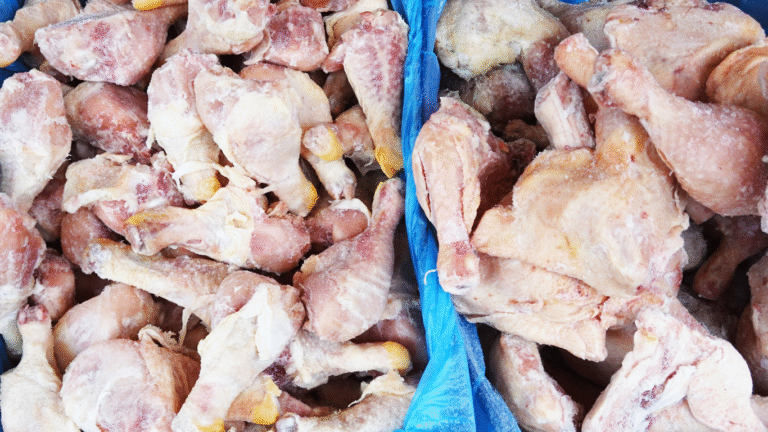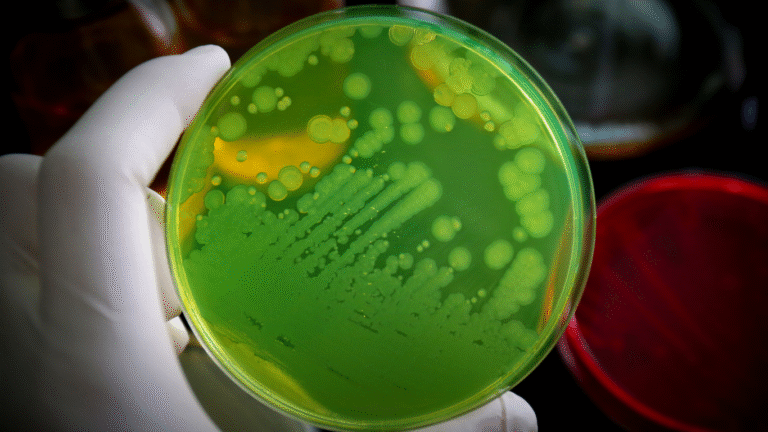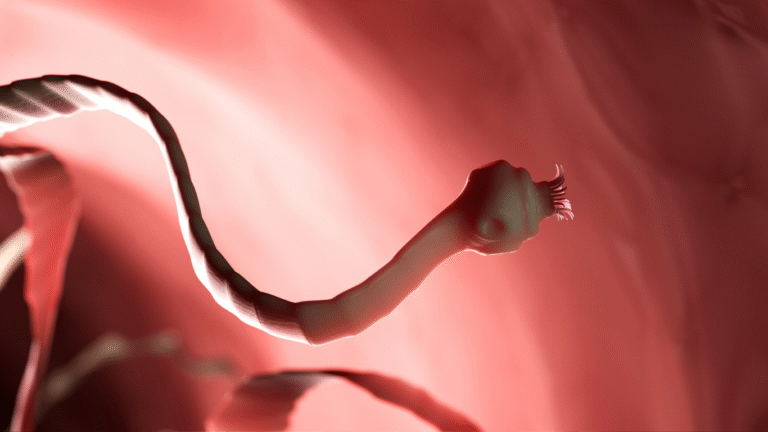Step inside the world of Salmonella. Learn how this tiny bacterium lives, spreads, and causes illness–and what you can do to prevent infection.

The day begins in the cool, damp comfort of raw chicken skin. For me, Salmonella enterica, this is home. The surface is moist, rich with nutrients, and alive with other microscopic neighbors. I spend my time multiplying, dividing in two through a process called binary fission. With enough time, our numbers swell into the millions, turning a single piece of raw meat into a bustling community of microbes. Life is predictable, steady, and for a bacterium like me, full of opportunity.
But life here never stays the same for long. Humans are hungry creatures, and sooner or later, this chicken will not remain in its raw state. When it is brought into a kitchen, everything changes. If humans cook the meat thoroughly, the heat is more than enough to destroy us. High temperatures are lethal, breaking down our delicate structures and leaving no chance of survival. However, humans are not always careful. If they do not cook the meat all the way through, or if the juices from the raw poultry spill onto a salad, a countertop, or a cutting board, some of us survive. Those mistakes are our chance at moving into a new world–the human body. According to the CDC, Salmonella is one of the most common causes of foodborne illness in the United States, responsible for about 1.35 million infections every year.
The journey begins suddenly. I find myself clinging to a forkful of undercooked chicken, carried into a mouth and swallowed without hesitation. Down the dark tunnel I go, passing through the esophagus before dropping into the acidic storm of the stomach. This is the first true test of survival. Stomach acid is a harsh environment, strong enough to kill most of my companions. The burning sensation feels like fire to us, and for many, it marks the end of the line. Yet some of us are strong, equipped with the right defenses to survive this acid storm. We push forward, weakened but determined, until we reach the small intestine.
Here, the world changes again. The small intestine is warm, dark, and teeming with other microbes. It is crowded, competitive, and noisy in its own microbial way. Yet for me, it feels like an opportunity. I carry my secret weapon: tiny hair-like structures known as flagella, which allow me to swim and reach the surface of the intestinal wall. Once there, I use a different trick. With the help of special proteins, I manipulate the human cells themselves, forcing them to pull me inside. To the human, this process is invisible. But to me, it is everything–a way to hide, survive, and multiply in safety.
Once inside the intestinal cells, I begin to reproduce rapidly. My growing numbers irritate the gut lining, disturbing the normal balance and function. The human begins to feel the first signs of illness. A wave of discomfort hits: diarrhea, fever, abdominal cramps, and nausea. Sometimes there is vomiting too. These are the classic signs of a salmonella infection, also known as salmonellosis. The Mayo Clinic explains that these symptoms can appear anywhere from six hours to six days after exposure, depending on how much of us manage to survive and thrive.
But humans are not passive hosts. Their bodies respond quickly to invaders like me. The immune system recognizes that something is wrong and sends out white blood cells to fight. Neutrophils and macrophages rush to the site of infection, attempting to swallow us whole. Fever begins to rise, one of the body’s natural defenses, aimed at creating a hotter environment where bacteria like me have a harder time multiplying. The gut itself becomes inflamed, and the human feels pain as their body battles against my presence.
The struggle is fierce. In many cases, the human wins this battle on their own. If the infection is mild, the body manages to clear me out in about a week. Rest, fluids, and patience give the immune system the strength it needs to recover. However, the danger increases when some of us manage to slip out of the intestines and into the bloodstream. This is when things become much more serious. A bloodstream infection means we can spread throughout the body, reaching areas far beyond the gut. In these cases, the illness can turn life-threatening if not treated quickly. The NIH warns that vulnerable people–such as infants, older adults, and those with weakened immune systems–are especially at risk of severe complications.
If the infection spreads or worsens, doctors may turn to antibiotics to fight us. Drugs like ciprofloxacin or azithromycin can kill us off, stopping our reproduction and giving the human’s immune system the upper hand. Still, the use of antibiotics is carefully considered, since overuse can make bacteria like me resistant, a problem that continues to grow worldwide. For those who are otherwise healthy, the illness often resolves without antibiotics, leaving them tired but safe once the infection passes.
Eventually, the battle comes to an end. White blood cells destroy many of us, and the gut gradually repairs itself. Humans recover, though often with memories of a miserable week spent dealing with constant diarrhea, cramps, and exhaustion. For me and my colony, it is the end of the line–at least this time. Yet Salmonella is persistent. While one group is destroyed inside a human, millions more wait quietly on raw meat, unwashed vegetables, or contaminated kitchen surfaces, ready for another chance.
This cycle is why prevention is so important. Humans have the power to stop me long before I ever make it to their intestines. The CDC recommends simple but effective steps: cook meat and eggs thoroughly, wash hands and kitchen surfaces often, keep raw foods separate from ready-to-eat ones, and refrigerate food promptly to slow bacterial growth. These actions might seem basic, but they are the strongest tools humans have to protect themselves from infections like mine. Most of us never make it past the stomach acid if food is handled safely. Yet when humans get careless, we slip through, causing illness that could have been avoided.
For Salmonella, every undercooked meal is an opportunity for survival and reproduction. But for humans, it can mean a week of discomfort, dehydration, and sometimes hospitalization. The best defense is simple: good food safety. By cooking, cleaning, and storing food properly, humans can keep Salmonella out of their gut and avoid the illness we bring with us.
And so, my day ends here. My life as a bacterium is short, but my presence is powerful. For humans, I am both a reminder and a warning–that what seems like a simple mistake in the kitchen can open the door to a week of misery. Stay cautious, stay clean, and keep me where I belong: far away from your plate.








